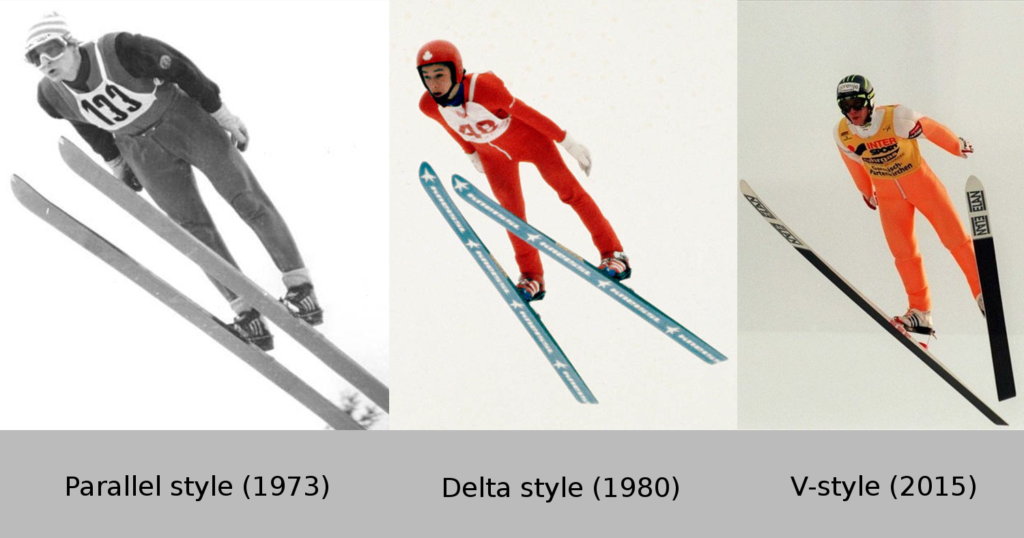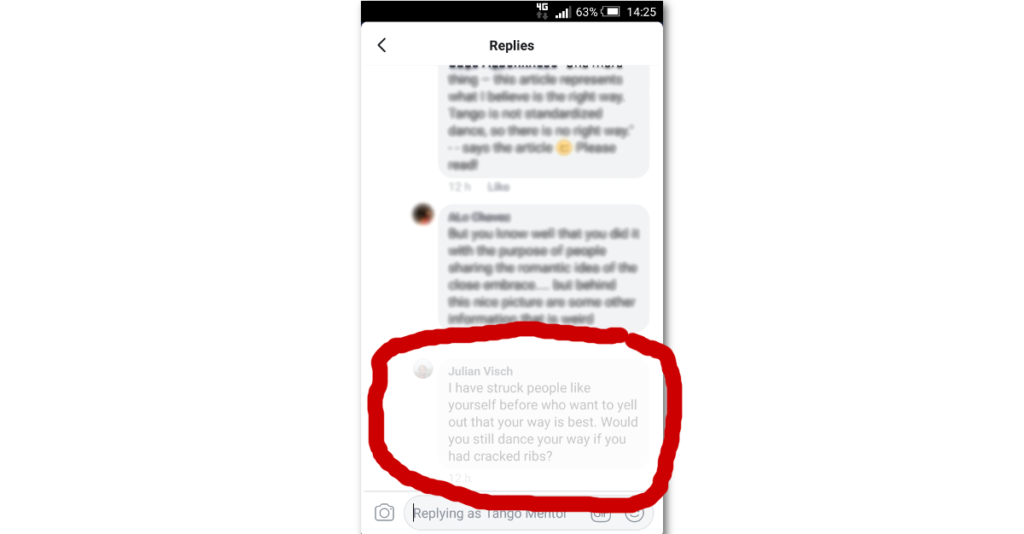
Last month when I wrote the “My mission” page I wanted to explain to my readers why I am working on Tango Mentor, what is the purpose of all these articles and pictures?
I didn’t expected that I will have to explain it this directly… and even more I didn’t expected some people to become so emotional about it.
Since many of them took time to write long comments to my article about close embrace, for sure they deserve answer – please consider this article as the answer.
The styles and the dogma
When Canadian Steve Collins entered the world of big international ski-jumping competitions, his competitors questioned whether he should be allowed to the big hill. He was so small and so young. He was only 15 years old.
Few months later, when he climbed on the hill of Salpausselkä in Lahti (Finland), anyone hardly expected what will happen.
“The wind was just rifling up the hill like you wouldn’t believe. I think its’ the strongest I’ve ever seen.” Collins recalled.
It was March 9, 1980. What he did that day will be remembered by sport history.
He climbed on the hill, he jumped and he left the gold medalist behind by 9 meters. He also made a record which stood for 12 years.
“I have never seen anything like it. He seemed to jump twice: once when he took off from the inrun and once again about half way trough the flight – you could actually see him lift up again”, a spectator remembered his flight few years later.
You can see his historic flight in Lahti on this video
Collins, a slight figure at 5-foot-5 and 115 pounds, has previously told reporters:
“I do it just for fun. I just like to fly.”
But that was not his secret…
Collins secret was his “delta style” jumping – a modified (reversed) version of V-style, developed in early 1970s. You see, the predominant style of ski-jumping from 1950-1990s was the parallel style and the judges on the big competitions awarded a perfect parallel style.
In 1969 the Polish ski-jumper Mirosław Graf discovered that the jumps are much longer if you use the V-shape, but he was not taken seriously by his contemporaries. He was nonetheless aware that the V-style was highly effective, as his jumps became considerably longer.

Collins was the youngest winner of a World Cup event at the age of fifteen, but his technique never caught on. During this era, any technique aside from the parallel style was considered inappropriate. Although it enabled much longer jumps – up to ten per cent more than the parallel style – judges made it an issue to award poor marks to those who used it.
The V-style only became recognized as valid by judges in the early 1990s, following wins and high rankings by Jan Boklöv and Jiří Malec, who insisted on using the technique despite receiving low style points. By the mid-1990s it had become the predominant style of jumping used by all athletes, and was therefore no longer penalized as it had proven to be both safer and more efficient than the parallel style.
Now, you might ask “Why is he telling me about ski-jumps when I am interested in tango?”. This example is important to illustrate that what is accepted as the truth or a predominant style is not necessarily the best approach.
Often exploring other approaches leads to best results. It took people who didn’t care about what was predominant style, like Jan Boklöv and Jiří Malec for the things to change.
It is good thing that in social tango, we don’t need to wait for the things to change. I am responsible for my dancing and you are responsible for yours. There are no judges – the ultimate judge is your partner and the pleasure you are able to give him/her.
Be like Collins, try new things and if you see that it gives results use it, despite what famous tango celebrities tell you. But, before doing that, please be sure that it really works – don’t use this recommendation as an alibi for bad dancing.
I am ridiculed and attacked by people who don’t know me and never danced with me. In the same time, some of them invite some of my students to their events giving them compliments that they are great dancers…
I know that what I am talking about works, no matter what they say. They are pressuring me not to spread this “bad advice”, but I believe that it is true, because it works. It works the same way that V-style worked for Graff and Collins.
I don’t need their approval to spread what I think is best for my students… at the end, people are not stupid – they can discover for themselves what works best.
The form you have selected does not exist.
The forbidden knowledge
To say I was under pressure these days is understatement. To be honest, I wanted to make a sharp distinction and express that I don’t agree with some of the widely accepted “truths” about tango, but my intention was never to have that much shares or publicity (thanks for that!)
… and certainly, my intention was not hate or violence:

(the letters are gray because I blocked him and reported him to Facebook)
And this was publicly said… I don’t want to even start to tell what I received as a private messages.
C’mon guys it’s just tango! If you don’t like what I write don’t read and don’t share – just block my content. I will be happy not to have you among my readers. If you don’t like it, I have nothing to say to you – I will work for those who like it and those who believe that it helps their dancing.
… and, despite loud words from many, there is a silent group that supports me. I received many private messages of support and even a donation to continue my work.
Maybe you don’t see it, but some people need this knowledge to have few better tandas in every milonga.
I am talking here about those who are not satisfied with what is offered and who feel that there should be something more…
Well, there is something more…
“I just finished a 2 month tango course with an Argentinian couple. He used to be the student of Puppy, Pepito, Todaro. Among many things he showed to us, he also pointed out all Youtube videos showing his masters dancing. Surprise: all used an open embrace, something between number 2 and 3, at all times!”, said one of the commentators to my article.
Yes, Puppy, Pepito and Todaro were great masters of tango and they should be respected. Tango today would have not been what it is without them.
But what about Gavito and Vidort? How come they and their style are erased from history of tango? How come dancing apilado style, that they used in their dancing, is wrong? Trust me, there are dancers who don’t even know who Gavito was.
If you disagree with my approach, I ask you – please, stop reading this article at this point… It is written for those of my readers who like using apilado when they dance, those who don’t enjoy open and similar positions.
If you disagree, you have enough material online about your approach, so – happy consuming! 🙂
The apilado
Tango is not standardized dance. There is no supreme authority to decide what is correct and what is wrong. That is the beauty of tango – people express their personality and they dance the way they are.
And… when you say tango – there is no ONE tango. Tango had diverse styles even in the Golden Age. Different barrios had different approaches and different periods also developed different styles.
The friction and conflicts are not new phenomenon in tango – that was present in the Golden Age as well.
“Even the old milongueros called us a bunch of queers for dancing that way, more upright, with pauses and silences. They were used to a more staccato tango. The old milongueros don’t like Pugliese – those before my generation…”, says Cacho Dante about his youth in the late Golden Age of tango.
A “bunch of queers” seems a bit harsh, don’t you think so? Yes, conflicts were always a part of tango and the styles always existed side by side. Everyone danced like they feel suits them.
But what is this “more upright dancing”? It is the apilado style, which Cacho Dante uses. I received some messages of people asking me to show them some videos of apilado dancing and I decided to add few in this article.
But before that, people please – have in mind that this is just performance. Apilado is a technique to be learned, you don’t just lean on your partner saying “I am dancing apilado!”
Hey, sorry to interrupt…
Do you like reading my articles? If you do please consider a small contribution to the existence of this blog.
I don’t sell a book or run ads: I share these articles for free. Unfortunately I also have to pay my bills, so if you see value in my work please consider a small donation/gratuity (the same way you tip your favorite bartender).
From my heart to yours!
Ivica
Securely processed via PayPal
Also, apilado in social dancing is not drastic like some of these videos. It is subtle play of axes – you dance a period leaning and the next moment you are on your own: it all depends on the music and the feeling you want to express. Viewers sometimes even can’t notice if someone is dancing apilado.
It also depends on the partner – does (s)he feels secure enough to do it – please don’t force your partners in apilado if they don’t feel comfortable.
So, here are some of the videos of apilado dancing:
1. Carlos Gavito and Marcela Duran
2. Ricardo Vidort and Anna Maria Ferrara
3. Nestor La Vitola and Enriqueta Kleinnman
4. Horacio Prestamo and Geraldine Rojas
5. Cacho Dante and Maya
6. Gerardo Quiroz and Mara Cicerano
7. Pablo Rodriguez and Eva Gerlez
And yes, I had some classes with some of the dancers mentioned above. I will not tell their names because I want to save them from the pressure I was exposed these days – what I write here is my own thinking, don’t blame them.
So, apilado is and always was a part of tango history. No matter how much the dogma of “no-axes-sharing” dancing is being preached around, dancers here and there discover this way as more pleasant and better suited for what they need in milongas. Of course, there are those who will never accept it, but don’t blame us who love it! We are just hopeless huggers!
… and the more intimate the embrace is – the better!

Hi,
I wrote this to Marcel Duran:
Hi Marcela! I am a big fan of you and Gavito. Is there a trick not to hurt my back in doing the position in the picture I am sending you (apilado) and which we see in many videos of you and Gavito. I’m 60 years old and have a new teacher of 28 – very talented! ( only had one private course with him yet). Yesterday, we danced the last tanda and he brought me there. I like it but just don’t want to be hurt. Also I’m overweight ( …. 25 lbs) but it does not stopped him.
And she answered:
« For social dance I don’t recommend the big tent. This is for performance. For social it should be small, confortable for both, and he needs to give you a lot of contact with his chest, for you do not colapse on the lumbars to prevent pain ».
—————-
Ivica, I am a big fan of you too.
I hope to go in your country to have some lessons with you. But I don’t think it will be in 2021… may be 2022
Very happy to tell you that I will return to tango on June 9 2021. I asked a man which I like the embrace and he accepted to dance with me: because of Covid, places are limited to 12 couples, it is outside and we have to keep the same partner.
Looking to the videos, I realised that I am more apilado than not. But more in the subtle way.
Yes, she is absolutely correct… like everything on the stage too much apilado is not OK. It should be subtle and in context.
<3
Thank you for sharing your thoughts. I love apilado style. Hope you continue to spread your message.
buy viagra online cheap
how much does viagra cost online http://viagrasy.com
is there really generic viagra
[url=http://viagrasy.com]cheap viagra free shipping[/url]
order viagra online clinic uk http://viagrasy.com
Thank you for this informative follow-up article. I especially appreciate your including the videos to demonstrate your point. I had shared your original discussion on my FB. Just as you wrote then, the topic was controversial and generated many comments and reactions. To me, this shows that your work is a valuable contribution to tango. Keep it up, please.
Thank you Masanori, I really appreciate your support… that gives meaning to my work! Tango on!